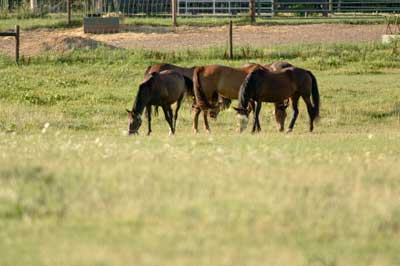Good pasture can provide economical feed for horses
Additional pasture yield can reduce the amount of purchased “high priced” hay.
 Horses are a big part of Michigan agriculture and with the high prices for hay due to last year’s drought (2012), horse owners are hoping for timely rains this spring for their pastures. Michigan State University Extension has some basic principles for developing and managing horse pastures.
Horses are a big part of Michigan agriculture and with the high prices for hay due to last year’s drought (2012), horse owners are hoping for timely rains this spring for their pastures. Michigan State University Extension has some basic principles for developing and managing horse pastures.
Careful consideration for each pasture should be planned in advance of any long-term decisions. Plan to have separate exercise areas, sacrifice lots when the ground is wet and saturated, and a riding arena to preserve the pasture as a feed source. A good pasture should not be over-grazed since this will decrease the ability of the forage to recover for high productivity.
The general recommendation for pastures is one horse for every two acres of pasture when allowed continuous access to the pasture. Dividing the area to be grazed into smaller paddocks and rotating the animals allows time for the grass to rest and regrow. Letting horses graze continuously can cut the carrying capacity by one-third. Consider rotating horses to another pasture when grass is 4 inches in height. Temporary fencing such as fiberglass or plastic step-in posts and electric tape is less expensive than permanent fencing and offers an option for subdividing your existing pasture. Make sure horses are trained to respect electric fence before being placed in a large area.
Improving existing pastures through a fertilization program, interseeding or changing grazing patterns can improve the pastures potential. Soil fertility is always an important component for a well-managed pasture. Take a soil test to know current fertility levels and then follow recommended fertilizer rates to increase annual production.
When seeding new pastures or hayfields, using improved forage varieties to last five years or more should be the goal of every horse owner. Improved varieties have been proven to have increased yield, palatability and increased disease resistance. For a list of varieties that have been tested, go to the MSU Forage Information System webpage.
Although these are some basic principles that can be used by horse owners, there are more options that may be appropriate for your operation.
For more information, contact Phil Kaatz at 810-667-0341.



 Print
Print Email
Email